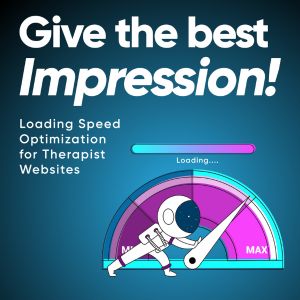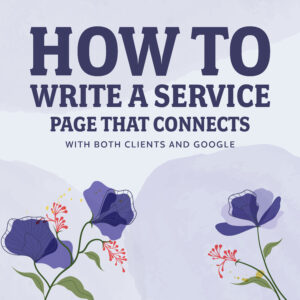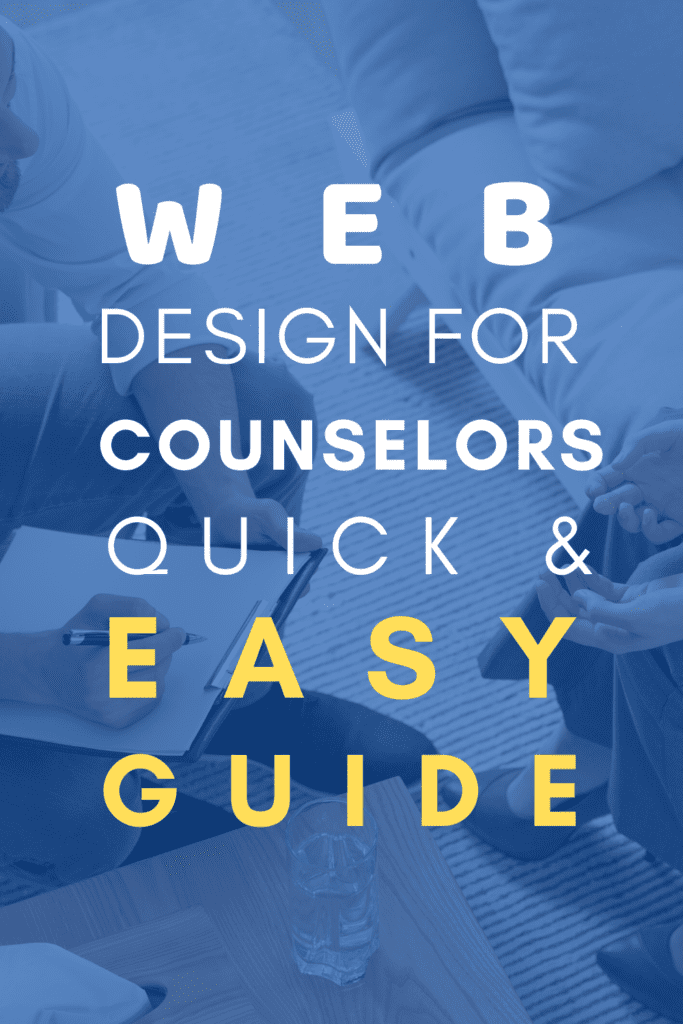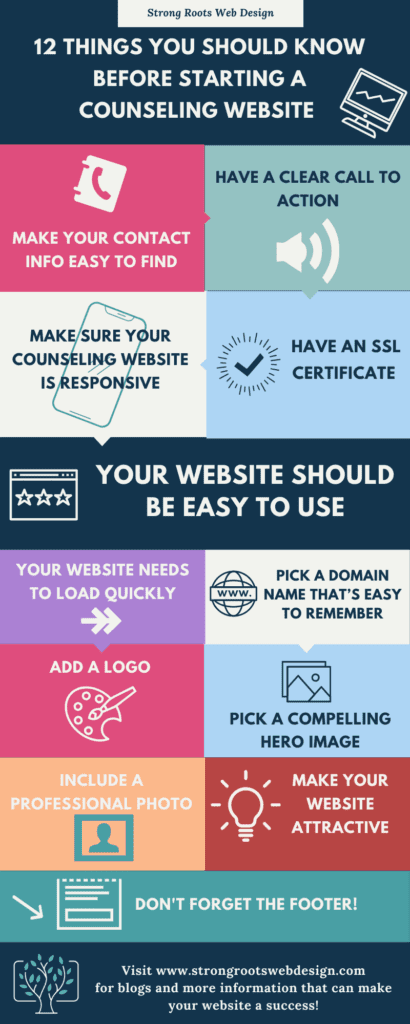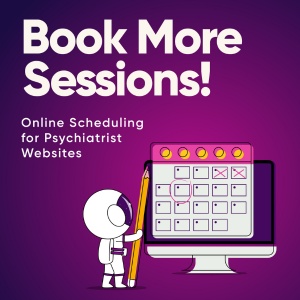
4 Ways to Identify Web Design Goals for Your Therapy Website

An effective site for your practice starts with identifying web design goals for your therapy website and prioritizing them in its’ design. Whether you’ve had a website for some time and it needs a good refresh or if you don’t yet have a website, but you’d like to, the starting line is the same.
You have to set a goal.
Okay, sure, but what does that mean?
When we talk about setting goals in our personal lives, most of us have a good idea of what that looks like and have solid examples that spring to mind – walk/run a 5k, start a daily meditation practice, eat 2 servings of vegetables with dinner, etc.
When we talk about setting web design goals with a therapy website, it’s not as intuitive. We might not have a readily available example in mind. So we have to go back to basics and answer the following questions:
- Why do I have a website?
- What do I want my website to do?
There are the obvious answers- “I have a website because everyone has a website,” and “I want my website to help my business.” While these answers may be true, they are not particularly helpful. Why not?
They’re simply too vague.
The answers you come up with will be the blueprint for your entire website and a vague blueprint is the perfect blueprint… for what may turn into a bit of a mess. The goals you set can influence everything about your therapy website, from the color palette to the layout to the content itself. Consequently, your interactions will be affected, from the people you reach, the connections you make, and the reputation you build.
With so many aspects of your practice affected by the goal of your therapy website, it’s easy to understand why identifying your goals is vital. But where do you start? Though every business and every website is different, here are four common website goals that can help you get started.

Web Design Goals #1: Bring in new clients
If a potential client searches for “therapists near (their town)” or “counseling for (their demographic)” or “why do I feel so (their current struggle)?” would they find you in the top few Google results?
Of course, we always hope so, but it’s not always the case.
You know you have a valuable service to offer. You also know that, regardless of value, people tend to click on one of the first results they see on Google and that you need to be among those top results to successfully reach new people.
Having a website makes it easier to find you. If used strategically, it can put you in those top results and make you more accessible to all those who Google mental health topics—people who are ready to make the call as well as folks who are exploring and looking for trustworthy answers.
Either way, if you want their search to point them in your direction, you have to have a website.
Web Design Goals #2: Help clients feel prepared for their appointment
“What suite is the office in, again?”
“What will this first session be like?”
“What if I don’t know what to talk about?”
Your clients may have a lot of questions leading up to their first appointment. Consider questions you’ve repeatedly been asked in the past. What kinds of concerns do people usually have around starting therapy? What things often hold them back? Those are concerns worth addressing and make addressing them one of your goals in building your therapy website.
And, of course, for the more practical worrier – where should they park?
Your website can do it all. You can answer the concrete questions directly and answer the more abstract questions indirectly through relevant blog posts and/or an FAQ page.
This saves your client stress and starts the conversation and relationship with them before they even make it through the door, putting you both one step ahead of schedule when the appointment begins. And who doesn’t love being ahead of schedule?

Web Design Goals #3: Provide resources to current, potential, and prior clients
The therapeutic conversation starts on your website. It can later continue on your website, too.
If you find yourself recommending the same activity, worksheet, book, or activity over and over again, referring to individual clients one at a time, you may be suffering from not having a website or from underutilizing the one you do have.
It’s time to work smarter, not harder, and make letting your site do the heavy lifting one of your goals in your therapy website.
One of the great things about how connected we all are by the web is our increased access to information of all sorts. You can make your recommendations and information that is relevant to your practice accessible by anyone who uses your website.
When all of your resources live on one page, it is much easier to direct people to them and much easier for a client to find again and again. Even if they’re not a client anymore and they just need a refresher on a concept you worked on together.

Web Design Goals #4: Build trust
Even those who don’t read the content or access the resources on your website are positively affected by the fact that you have a website at all. Similar to the way people gravitate toward top results on search engines, people gravitate toward practices—and really, businesses of all kinds—with a decent online presence.
Consider the way you shop for a product or a service that you’re investing in. Do you look it up first, skim the website, make sure you roughly know who you’re giving your business to? Many of us do.
Having a well-managed online presence can be the difference between you being just another address and phone number on a list and being the person a client reaches out to. Bonus points from Gen Z if people can reach out to you without calling, through a contact form, email, or text message.
A decent online presence isn’t enough on its own, though. Building trust with potential clients sometimes means building trust within your community or industry, too. One good way to do this is to flex your research skills and craft original, accurate, and easy-to-read content. By “easy-to-read” we mean plain English, a standard font size, thoughtful formatting, and black text color (versus many or contrasting/hard-on-the-eyes colors).
So what’s the big deal about making difficult concepts easy to read and understand? First, you can help more people than a stuffy academic paper would. Second, your website might just become a go-to source on your chosen topic. And that is an excellent way to build and maintain trust within your community and with potential clients, which should be one of your goals in your therapy website.
Though these are just a few examples, you have a lot of options to mull over to answer two little questions- “why?” and “what?” And those questions are just the beginning.
It seems daunting, but there’s no need to fret. While you establish your “why,” and “what,” we’ll get to work on the “how.” It’s what we do!
We’ll evaluate your online presence as-is, help you articulate your web design goals for how it could be, and design a plan that will turn that “could be” into a “will be.” Reach out to schedule a consultation with us today.
Did you like this post? Share it!
Related Reads for Starting and Branding Your Practice:
- Branding And Therapist Logo – Use Your Therapist Logo Consistently
- Branding Your Mental Health Private Practice
- Professional Website Fonts: Choose the Right Typography for Your Therapy Website
- Counseling Practice Names for Branding and Website
- Photos for Your Therapy Website | Counseling Stock Photos
- Logo Designer – Looking for a Professional Designer
- Benefits of a Logo for your Therapist Branding
- Therapist Logo Design – Define Your Brand Identity
- Therapist Logo Examples – Inspiration for Therapist Logos
- Therapist Logo Ideas – Find Inspiration in the World Around You!
- Different Logo Types for Therapist Business Branding
- Your Therapist Logo: The Ultimate Guide – Therapist Website Design
- Tools for Small Businesses: Low-cost Social Media Tools For Your Biz
- User-Friendly Website Templates For Therapists
- Web design for Counselors – Private Practice Websites
- Web Design for Psychologists: A simple guide – Therapist Website Design
- Website For Forensic Psychology Practice –4 Factors to Consider When Choosing the Best Mental Health Website Design
- 4 Ways to Identify Web Design Goals for Your Therapy Website
- How to Choose Your Therapy Niche and Get More Clients
- I Want a Website for My Business: A Beginner’s Guide to Getting Started
- Affordable Web Designers for Therapists: Expert Solutions Guide
- Affordable Website Development for Counseling Professionals
- Tips on Website design for Mental Health Professionals
Need any of the following?
- Web Design And SEO Services
- Done-For-You Therapist Website Template
- Professional and Customised Web Design
Here are some Sample Websites We’ve Created:
Check out our Portfolio for more!
Hi! I’m Sarah.
I help counselors and therapists have a bigger impact on the world through better client connection. I do this by creating beautiful visuals and strategically designed websites.








